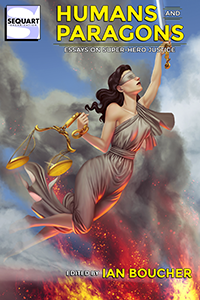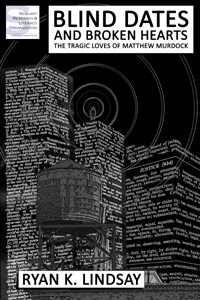Daredevil 25
By Mark Waid (writer), Chris Samnee (artist), Javier Rodriguez (colourist), et al.
This issue requires some context. Up until recently Mark Waid’s series has seemed completely episodic. Just a few issues ago everything was revealed to be interconnected. Mark Waid revealed that most of the comic up until that point was a vast conspiracy orchestrated by a mysterious figure. Issue twenty five is the first clear and direct action on the part of this mysterious force. Gone is the pretext, Daredevil is directly attacked by a self-proclaimed agent of this mysterious force. This issue has to be important. It has to be dramatic and memorable. Mark Waid decided to write an almost issue long fight scene. In most cases a decision like this would make me cringe. Daredevil is fairly brilliant though. Mark Waid and Chris Samnee make this long fight scene work.
The issue starts with Daredevil arriving in Foggy’s hospital room. There is an escaped convict in the room. The convict reveals he might know one of the villain’s bases of operation and offers to lead Daredevil there. The locale turns out to be an abandoned warehouse. Matt Murdock immediately reveals that he knew this was a trap. He tells the convict to get to a hospital- the villains have implanted him with a pacemaker so his steady heartbeat makes Murdock think he’s telling the truth, however Murdock worries that the pacemaker will be rigged to kill the convict. The convict then dies. Daredevil realizes whoever set the trap doesn’t even care that it’s obvious. Daredevil leaps into the warehouse. A figure, cloaked in Murdock’s father’s robe, and explains that he was exposed to the same chemicals that blinded Murdock- and gave him his powers. The figure disrobes, revealing a Japanese influenced version of Daredevil’s first costume; he carries two Kusurigama (which aren’t actually Kusurigama), and says his name is Ikari, which is Japanese for “fury.” Daredevil’s first attack is promptly countered by Ikari, who clarifies something for Daredevil: they both have radar sense. Murdock leads him outside, assuming the warehouse was selected because it’s easier on someone with newfound super senses. He hopes that luring Ikari into the streets will tip the scale in his favour. Ikari seems unfazed as he follows Daredevil onto a tight rope. After a quick altercation Murdock is left seriously bleeding on one arm. Ikari then cuts the tight rope, sending them both falling downwards into the city. Ikari lands gracefully on a fire escape while Daredevil can barely halt his fall; he has to grab a fire escape, horribly straining his injured arm. Daredevil then flashes back to training with his mentor, Stick. Specifically he remembers what he learned after Stick threw him off a building. Daredevil, following this past lesson, reaches an appropriately Zen state. He grabs Ikari’s incoming blade and sends them both falling to the street. They crash into a window and begin an intense bout of fighting. Essentially they just pound each other, turning the fight into an endurance test. Daredevil gets wise though, he extends his telescoping billy club, trapping Ikari’s throat. Daredevil leaps away. Ikari follows and Daredevil tries to keep him back with the club turned staff. Ikari snaps it in half. Daredevil realizes he has to press his sole advantage. Ikari hasn’t had time to master his radar sense like Daredevil has, so Daredevil leads him into a sporting goods store. The clutter of the store is meant to throw Ikari off, but to really blind him Daredevil sets off the sprinkler. The idea that tons of tiny objects would wreak havoc with radar sense has appeared before in the series, but that time it was with confetti. Daredevil’s plan is to expose Ikari to something he can barely see through under the assumption it will give him the advantage he needs. Daredevil reaches for a baseball bat as Ikari rounds the corner. Ikari coldly remarks: “try the red one.” Daredevil realizes that Ikari may have super senses, but he’s not blind. Ikari then beats Matt Murdock with the red baseball bat, almost killing him. His real goal is to make Daredevil afraid; he lets him live, explaining that his masters could kill him at any time.
Mark Waid’s storytelling skills are displayed brilliantly throughout this issue of Daredevil. The issue is brilliant on its own, but even more so in the context of the series. For this story to work Ikari needs to seem terrifying. He has to be exceptionally threatening. He has to seem superior to every other villain in the series. Waid understands the best way to convey this: he shows, he doesn’t tell. He doesn’t explain that Ikari is dangerous, he shows it, and he shows it in a genius manner. Instead of something heavy handed and explicit he has Ikari beat Daredevil at every turn. What makes that feel significant is that Daredevil thinks he’s just gotten the upper-hand each and every time. The fight slides from goal to goal, and each goal is presented as the final opportunity for Daredevil to win. Mark Waid never has Daredevil come out and say that he’s underestimated Ikari, or even that Ikari is some great threat in comparison to his other foes, the reader instead infers it. It is a very effective technique. Now this is only important in the context of the larger series, what really sets Daredevil apart from Wonder Woman are the aforementioned story beats throughout the fight. The first page of fighting is just Daredevil charging at Ikari, he then realizes that’s a terrible plan. Daredevil then tries to lure Daredevil into a dangerous and overwhelming situation. After that fails Daredevil is left struggling to pull himself up. He gains a Zen-like composure and brings Ikari crashing down with him instead. Then the fight becomes an endurance test; nothing but beating the shit out of one another in close quarters. Daredevil decides to extend his telescoping billy club to escape, and that goes off without a hitch. He decides to use the pole to keep Ikari at a distance while he regains some energy and makes a plan. Ikari breaks the pole in half almost casually. Daredevil decides that mindlessly exchanging blows in the hopes that Ikari falls first is a terrible plan, so he leads Ikari to the store. In Wonder Woman…Hermes and Diana fought. That’s it. Daredevil’s story beats make the fight feel pointed, it eliminates the kind of directionless squabbling that Wonder Woman had. Having goals conveys a sense of urgency to the fight, making it far more exciting for the audience. It makes the audience less passive, suddenly they are involved, swept up in the action. Mark Waid also knows that having his characters exchange witty banter overtop of the action would only lessen the drama. Most of the fighting in Daredevil is silent, making it feel more realistic and significant.
The choreography throughout Daredevil is fabulous; Chris Samnee clearly knows what he’s doing. Samnee understand the principles of implied motion. One of the most important things an artist has to convey in a fight scene is motion, without it the fight scene is a waste of time. One of the most effective ways to do this is to pick out key moments from the fight and depict them, letting the reader fill in the blanks. Wonder Woman tried the same thing, except Goran Sudzuka picked poses that he thought looked cool. Chris Samnee picks a collection of moments, each with a clear relationship to one another. You can tell exactly what movements had to happen between this panel:
and this panel:
Chris Samnee raises the bar even more with his clear understanding of the human form, and more specifically his understanding of martial arts. The poses look real, characters are the right distance in relation to one another, and the characters’ body language conveys all kinds of important information. The intense bout of fighting after they crash into the window looks different from their fight on the tight-rope. Daredevil look exhausted during the last little sparring round between the two foes. All this information makes the fight scene a hundred times more effective. Suddenly we have a fight that not only has urgency and effective story beats, it has movement-filled, realistic, emotional, choreography. That helps set it above most movie fight scenes, let alone comic book action scenes.
The pacing throughout Daredevil is very effective. Chris Samnee never drastically misuses panels. Generally he seems to understand the effects his choices have. There are a few panels I would argue could be improved, but they’re still fair choices. Samnee makes a lot of excellent choices too. He uses his pacing to accentuate the content of his panels in a really skilled manner. Take a look at the page where Ikari breaks Daredevil’s staff:
Using irregular shapes as panels can be brilliant. People like Frank Quitely and Chris Burnham manage it. It can also be terrible:
Samnee uses these irregular shapes to make the movement in the panels feel graceful and swooping. Take note of the way the wider end of the panel follows with Ikari’s movements. It subtlety draws attention to the motion of his arms; he ducks and begins wrapping his arms around the staff, he extends his one arm, and he draws his arms back together dramatically. The panel slides with the movements, creating a wonderfully effective moment. He uses irregular panels to build tension at one point earlier, which also works well. He even uses inset panels really well. What makes the fight scene’s pacing good though, is the overwhelming simplicity of the layout. The focus is on the content not the form at all the right times. The sum makes for a fight scene that does everything right. It does all those things I mentioned earlier and it does them well.
And next time . . . something completely different.






















































